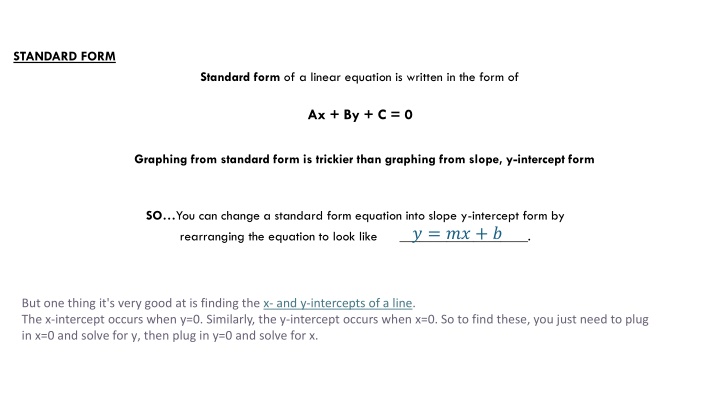
Linear Equations: Graphing in Standard Form vs Slope-Intercept Form
Learn how to convert linear equations from standard form to slope-intercept form for easier graphing and interpretation. Discover how to find intercepts and analyze slopes and y-intercepts to graph lines effectively in mathematics.
Download Presentation

Please find below an Image/Link to download the presentation.
The content on the website is provided AS IS for your information and personal use only. It may not be sold, licensed, or shared on other websites without obtaining consent from the author. If you encounter any issues during the download, it is possible that the publisher has removed the file from their server.
You are allowed to download the files provided on this website for personal or commercial use, subject to the condition that they are used lawfully. All files are the property of their respective owners.
The content on the website is provided AS IS for your information and personal use only. It may not be sold, licensed, or shared on other websites without obtaining consent from the author.
E N D
Presentation Transcript
STANDARD FORM Standard form of a linear equation is written in the form of Ax + By + C = 0 Graphing from standard form is trickier than graphing from slope, y-intercept form SO You can change a standard form equation into slope y-intercept form by rearranging the equation to look like ___________________. ? = ?? + ? But one thing it's very good at is finding the x- and y-intercepts of a line. The x-intercept occurs when y=0. Similarly, the y-intercept occurs when x=0. So to find these, you just need to plug in x=0 and solve for y, then plug in y=0 and solve for x.
2. 3? ? 6 = 0 ? = 3? + 6 ? = 3? 6 ? = 3 ? = 6 ? = 3? 6
Using the Standard Form to Determine Intercepts 3? ? 6 = 0 To find out where this graph crosses the y axis, set x to 0 3 0 ? 6 = 0 ? = 6 The graph crosses the y-axis at the point 0,-6 ? = 6 To find out where this graph crosses the x axis, set y to 0 3? 0 6 = 0 3? = 6 ? = 6 The graph crosses the x-axis at the point -2, 0 3 Setting x to zero gives you the y-intercept. Setting y to zero gives you the x-intercept.
Example: Change x + 3 to slope y-intercept form. = y 2 6 0 3? + 2? 6 = 0 2? = 3? + 6 2 3 2 6 2 y x+ = 2 3 2 = + 3 y x What is the slope & y-intercept? ? = 3 y intercept is 3 2
Rearrange the following equations from standard form to slope, y-intercept form. ? + ? 3 = 0 ? ? = 0 2? + 5? 15 = 0 ? = ? + 3 5? = 2? + 15 ? = ? 5? 5=2? 5+15 ? = ? 5 ? =2 5? + 3 ? = 1 ? = 0 ? = 1 ? = 3 ? =2 ? = 3 5
CHANGE FROM STANDARD FORM TO SLOPE Y-INTERCEPT FORM, THEN GRAPH a)Rewrite the standard form equation in Slope y-intercept form ( y b)State the slope and y-intercept c)Graph and label the line = + ) and mx b 1. 2? + ? + 4 = 0 ? = 2? 4 ? = 2 ? = 4 ? = 2? 4
3. 3? + 2? 4 = 0 2? = 3? + 4 2? 2= 3? +4 2 2 ? = 3 2? + 2 ? = 3 2? + 2 ? =3 ? = 2 2
